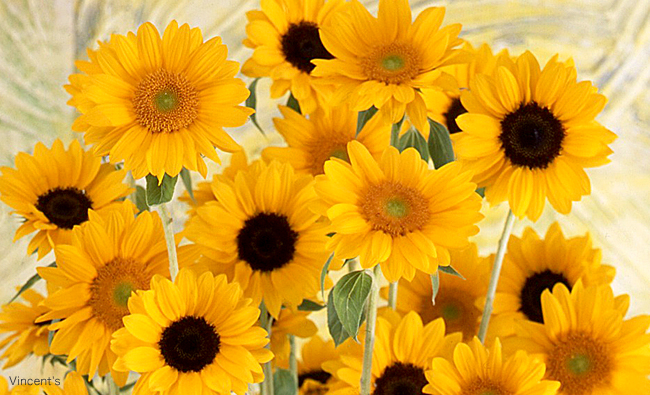- Top>
- Episode 03 Sunflower

Episode 03 Sunflower
What does a sunflower remind you of ?
When you think of sunflowers, you are reminded of sunshine and midsummer, and even looking at one can cheer you up. Because sunflowers have energizing, vibrant colors, in recent years, sunflowers have become a standard present for Father's Day.
The Vincent's series, which blooms facing upwards, consists of bright, vigorous, cheerful flowers that perfectly fit the image of fathers. With the Vincent's series sunflower, boost your father's energy levels a 100 times!
Sunflowers are not just in demand for Father's Day; their demand is also increasing for Mother's Day. Every year, sunflowers are cut almost as if summer is anticipated, and shipments of cut flowers are start earlier every year. Shipments of sunflowers start in early spring and increase until they reach their peak in July and August. There are two types: single flower and double flower. Besides the orange and yellow flowers which we are all familiar with, they also come in a rich variety of shades including brown, white and lime green.

Kagayaki
Nowadays, you can see sunflowers any time of the year, but they were originally long-day flowering plants and did not bloom easily in winter. Thus, they are summer seasonal products. Furthermore, they were produced less for decoration than for food or oil. Then, something revolutionary happened to the sunflower. In 1969, a private breeder from Fukuoka Prefecture named Reiichi Nakajima developed a short-day flowering variety called Taiyo (meaning "sun" in Japanese) which enabled year-round culture. However, sunflowers at the time produced pollen, which reduced their longevity and resulted in spoiling tables and the surroundings in which they were placed. Therefore, it was not feasible to use them as cut flowers.
In 1986, our company developed the first pollenless cut-flower variety called Kagayaki (meaning "sparkle" in Japanese). Because it was pollenless, it showed remarkable improvements in longevity and did not spoil its surroundings. Demand for sunflowers soared. Subsequently, various companies developed similar varieties and the demand for cut sunflowers increased.
Moreover, in 2001, our company developed several varieties of sunflowers reminiscent of famous paintings, beginning with Gogh no himawari (meaning "sunflower of Gogh" in Japanese), followed by the gentle yellow double flower of Monet no himawari (meaning "sunflower of Monet" in Japanese), the uniquely-shaped petals of Gauguin no himawari (meaning "sunflower of Gauguin" in Japanese) and finally, Matisse no himawari (meaning "Sunflower of Matisse" in Japanese). Collectively known as the "Painters series," they continue to enjoy high popularity.
However, although sunflower varieties are sold year-round, typical marketed varieties are still sensitive to day length. During long days, plants tend to get too high and during short days, they tend to get too short, requiring growers to meticulously select a variety which best matches their conditions. In addition, after harvesting, the flowers tend to turn face-down and germination is inconsistent, causing hardships to the growers of cut flowers. To solve these problems, we developed the Vincent's series.
Following the concept of the Painter series, we named it Vincent's from Van Gogh's first name. The Vincent's series is largely unaffected by day length, making it a all-purpose variety. It has a lovely shape with round petals, good overlapping and unlike other varieties, it does not turn down, but blooms facing cheerfully upward. Currently, the Vincent's series comes in two colors: "orange" and "clear orange." New colors are currently being developed. Please wait for new colors in the future.

Gogh no himawari

Monet no himawari

Gauguin no himawari

Matisse no himawari

Vincent's "orange"

Vincent's "clear orange"
Finally, there are short sunflowers for pots and flower beds. Konatsu ("little summer" in Japanese) has a plant height of about 25 cm, and of course does not produce pollen. Thus, the flowers are in bloom for a long time, about a month. When planted outdoors, stalks emerge continuously from the sides until the entire plant is covered in flowers. Often used for cultivation experiments at elementary schools and similar applications, it is the most popular variety of our spring-planting seed packets.
Energetic colored sunflowers will decorate our life from now on.




